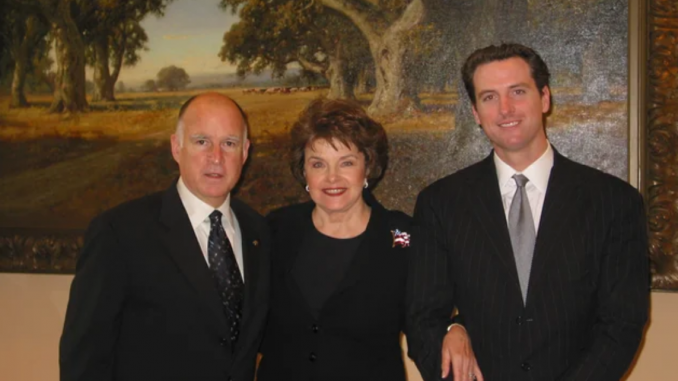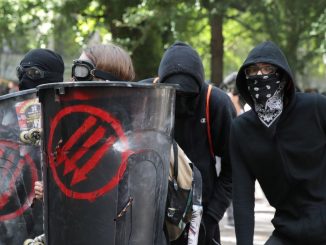
When San Francisco Mayor London Breed was caught on tape boogieing down maskless in a bar, violating the very stringent orders she herself imposed on the city, she offered a spirited defense of her actions: “We don’t need the fun police to come in and micromanage and tell us what we should or shouldn’t be doing,” she said, explaining, “My drink was sitting at the table. I got up and started dancing because I was feeling the spirit and I wasn’t thinking about a mask.”
The mayor was immediately accused of hypocrisy, but, like Governor Gavin Newsom, who just survived the recall election triggered after he was photographed dining out of compliance with his own pandemic orders, maskless and in a large company of lobbyists, or House Speaker Nancy Pelosi, who was recorded breaking masking laws in a hair salon, or Senator Dianne Feinstein, who was walking barefaced in an airport, Breed will weather the storm. It’s not that she’s a hypocrite—of course she is—but the central governing ideology of San Francisco is not life, liberty, and the pursuit of happiness, nor is it don’t tread on me. Rather, it is our elites care for us.
That ethos developed over decades. Longtime San Francisco resident and founding editor of Salon David Talbot describes the transformation of San Francisco from a 1950s working-class trade-union Democrat town into the hub of progressivism in his book Season of the Witch. It is a very confident piece of history, published in 2012, a few short years after Pelosi successfully rammed Obamacare—and, with it, San Francisco values—through Congress. Publication of Season of the Witch preceded the voter-approved Proposition 47 by two years; Prop 47, which was co-written by then-District Attorney of San Francisco George Gascon, a San Francisco machine politician, and then-Attorney General Kamala Harris, virtually eliminated punishment for many criminal activities, and is frequently blamed for California’s current twin nightmares of rampant criminality and drug addiction.
The beginning of San Francisco’s ordeal was a refugee crisis independently co-created by the national media and local activists. In January 1967, San Francisco hosted an outdoor festival, “A Gathering of the Tribes for a Human Be-In.” It was widely covered in the national media, creating a hippy mystique. In a few months, kids from across America poured into the city for what became known as the Summer of Love. While the Human Be-In was attended by counterculture visionaries ranging from Timothy Leary to Joey Ramone, the 100,000 kids who showed up in San Francisco in the months that followed were mostly the cult follower types.
The local anarcho-communist mime troupe The Diggers encouraged the arrival of kids who were unable and unwilling to work, with the intent of forcing the city to respond. The Diggers staged situational performances, teaching their followers that all possessions should be free. Runaway children and other miscreants loved the ideology, or at least found it useful. Charles Manson spent the summer of ’67 in the Haight-Ashbury district, collecting followers, dropping acid, and picking up ideas. He particularly liked dumpster diving, which he lifted from The Diggers.
At first the local officials dug in, but they still had to respond to the explosion of criminality and drug addiction. Psychedelic rock album covers notwithstanding, the Summer of Love drugs of choice were heroin and methamphetamines. Joan Didion noted that quite a few hippies arrived in San Francisco with raging meth addictions. Others, like Janis Joplin, possibly the second most repulsive character populating Season of the Witch, picked up the habit in the hippy Mecca.
Once, in a fit of free love, Janis injected a romantic rival with enough heroin to pass out. The rival, Terrence Hallinan, a scion of a prominent Bay Area family, recovered from the overdose, and, in 1996, was elected a district attorney of San Francisco. The reader can see that head prosecutor is a storied position in the City by the Bay—storied as in gossip-full. The current occupant of the office is Chesa Boudin, the proud son of unrepentant Weather Underground terrorists.
Although there is no denial that demographic trends altered San Francisco as families found it unlivable, Jim Jones was the man who flipped it progressive. The San Francisco-based cult leader held regular quasi-religious services, attracting a large flock of devotees of whom he took care in exchange for obedience—and participation in various welfare fraud schemes. He had close relationships with many Democrat politicians in the city, a tidbit of local history of which embarrassingly few Golden Gate City residents are aware.
Jones’s biggest impact on history was fixing the 1975 election for Mayor George Moscone and a number of other far-left candidates. Talbot spoke with his son Jim Jones Jr., who acknowledged the election theft but reasoned that such tactics were justified because so much good came out of the progressive takeover of the city. In other words, for the drug-addled communist cult leader known for engineering the murder-suicide of more than 900 people, most of them black, to engage in voter fraud is all good because it was in the service of a cultural revolution.
Talbot is in basic agreement, suggesting that, as malevolent as the ’60s and the ’70s San Francisco personalities might have been, the evil was necessary. It was the growth process that created San Francisco values. This transformation was needed, he proposes to the reader, because the city was then prepared to face the AIDS crisis, and we know that because then-Mayor Dianne Feinstein funded all HIV-AIDS programs. Feinstein, Talbot contends, was a great leader for late ’70s and early ’80s San Francisco; the city was in such a disarray, so incapable of self-restraint, it needed a meddling, restless mother figure—somebody to take care of it.
Unfortunately, Talbot’s narrative on AIDS neglects the fact that the city fumbled the response to the disease where it matters most for this particular virus, in prevention. At the onset of the epidemic, the San Francisco Chronicle buried the stories about the mysterious gay pneumonia on the back pages and in the letters section. The San Francisco Department of Public Health issued the order to close gay bathhouses only in 1984, allowing transmission of the STD to go on for years.
San Francisco is arguably the most progressive city in the union, and that is not a good thing. Talbot published his book before the explosion of homelessness paralyzed its city center and public transportation. Even then the signs were ominous, though. In 2009, during Newsom’s mayorship, the hard left publication San Francisco Weeklydeclared San Francisco to be the worst-run big city in America. The problem with this assessment is that San Francisco, whose population never exceeded one million people, is too small to be a big city. Because of its size, it should be expected to run smoothly.
Yet the city now has a budget more than $12 billion, bigger than some small states like Rhode Island, Maine, or Delaware. About 10 percent of that is allocated to homeless services alone, feeding its notorious homeless-industrial sector. Although it is hard to believe that the agencies and nonprofits working to solve the homelessness crisis don’t see that it is caused by mental illness and drug addiction, they evidently have no qualms about taking public money and spending it on what is essentially enabling individuals living in crisis. In the best tradition of The Diggers and People’s Temple, they put up temporary accommodations, often in public spaces, and pass paraphernalia.
Homeless services might be the most visibly persistent example of corruption, but in the City of San Francisco the problem goes deep. For instance, London Breed’s former paramour, Director of Public Works Mohammad Nuru, is under corruption investigation by the FBI. If Breed had accepted gifts from Nuru, and that was apparently no big deal to her constituents, what is a little maskless clubbing?
In San Francisco, it is simply accepted that politicians deserve to live better than the rest of us. We defer to those in charge. Unfortunately, what started in San Francisco is not going to stay in San Francisco. It was Jim Jones’s dream to spread his web of influence to all of California, and then to all of the United States. His ambition was cut short by his madness, but he did manage to meet with First Lady Rosalynn Carter. Now the San Francisco machine is running the state, and the United States House of Representatives. And it has its pawns positioned to take over the presidency—after all, if Kamala Harris somehow misses it, there’s always Gavin Newsom.
*story by The American Conservative


